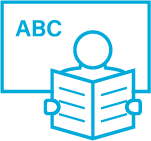Phonics Based Reading Interventions for Students with Intellectual Disability: A Systematic Literature Review
In this review, studies that focused on the implementation of phonics based reading interventions for students with intellectual disability (ID) were examined to determine certain factors, such as what type of settings are typically used and what type of interventions are being implemented. Results indicate that students with ID continue to respond to phonics based reading interventions and there is an increase in published studies involving phonics based reading interventions for students with ID.
Author: David R. Hill
Source: Hill, D.R. (2016). Phonics based reading interventions for students with intellectual disability: A systematic literature review. Journal of Education and Training Studies, 4(5), 205-214. Doi: 10.11114/jets.v4i5.1472
For students with ID, teachers require interventions that are simple and efficient and can be implemented in the classroom. In this review, studies that focused on the implementation of phonics based reading interventions for students with ID were examined to determine the salient factors, such as what types of settings are typically used and what types of intervention are being implemented. Results indicate that students with ID continue to respond to phonics based reading interventions and there has been an increase in published studies involving phonics based reading interventions for students with ID.
- The emphasis and methods of reading instruction for students with ID have changed over the past several years.
- The initial focus was on teaching functional sight words to enhance daily living skills for students with ID.
- The mode of instruction primarily involved drill and practice exercises that only targeted word identification and other isolated reading skills.
- While students have learned to identify words, they have experienced great difficulty in reading connected text.
- Research focusing on phonics based reading interventions for students with ID is increasing. Moreover, the findings from two reviews are encouraging and provide support for the use of phonics based instruction for students with ID.
- Conners (1992) concluded that children with moderate ID respond to various forms of phonics instruction.
- Joseph and Seery (2004) concluded that some students with ID are capable of generalising acquired phonetic analysis skills.
Different forms of phonics instruction:
- Stimulus-connected prompt fading technique
- Phonetic analysis with error correction
- Comprehensive literacy programme using embedded phonics instruction
- Computer-assisted instructional approaches
The purpose of this review was to update prior reviews and examine studies that have implemented phonics based reading interventions to students with ID to answer the following questions:
- With whom and in what types of educational settings has phonics instruction been evaluated?
- Which approaches to phonics instruction have been examined since the last review?
- How effective are explored phonics interventions for students with ID?
- Is there evidence for an increased focus on phonics instruction for students with ID since the previous reviews?
In total, 11 articles met the inclusion criteria and were reviewed. In the included articles, Ns varied from 3 to 93 and the subjects ranged from kindergarten age to 15-year-olds.
Findings
- A total of 240 participants with ID and an age range of 6–15 years participated in the 11 studies.
- Five studies evaluated interventions within participant classrooms, while two provided interventions for participants outside their special education classroom.
- Interventions were classified into two groupings: a) researcher-designed approaches that incorporated various aspects of systematic, explicit instruction, and the use of published reading curricula (such as corrective reading); and b) interventions consisting of evidence based response-prompting procedures (such as simultaneous prompting).
- Studies with the longest durations tended to report higher reading improvements, with effect sizes ranging from d = 0.30 to 0.88.
Interventions used:
- One intervention targeted concepts of print, phonological and phonemic awareness, oral language, letter knowledge, word recognition, vocabulary, fluency, and comprehension.
- An Early Literacy Skills Builder (ELSB) intervention targeted vocabulary, comprehension, phonemic awareness and early phonics skills.
- Corrective Reading Program Decoding A is an established, systematic, explicit reading programme with a focus on decoding skills.
- The synthetic phonics intervention consisted of participants learning individual letter sounds and how to blend them to make words.
- The analogy phonics intervention consisted of participants learning sounds of common consonants and common ‘rimes’ and combining them to read words. Participants were asked to practice reading the words and saying the letter sounds before attempting to match pictures with the sounds/words.
- Simultaneous prompting involves the simultaneous delivery of the controlling prompt and the instructional cue.
Implications
- Reported results from the 11 studies reviewed indicated varying degrees of reading improvements as a result of their respective reading interventions. Further, they provided more evidence supporting the efficacy of phonics based interventions for students with ID.
- All studies used a systematic and explicit approach to instruction.
- Interventions were implemented either one-to-one or in a small groups, with each session lasting an average of 32.5 minutes.
- Further examination of the effects of letter-sound correspondence, letter groups, and syllables on reading instruction with students with ID are encouraged.



